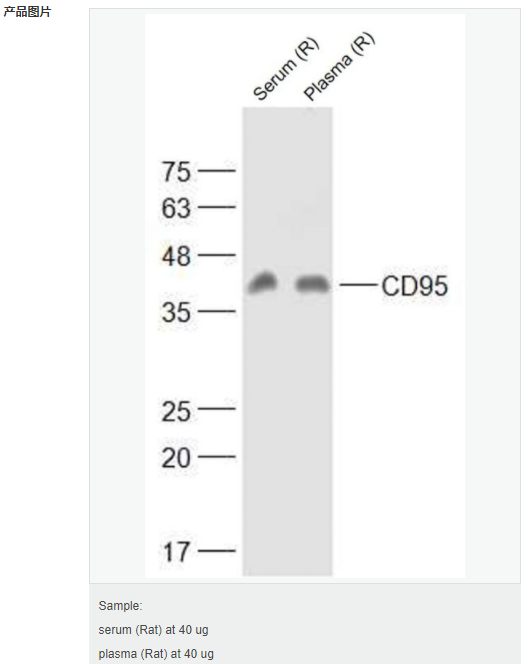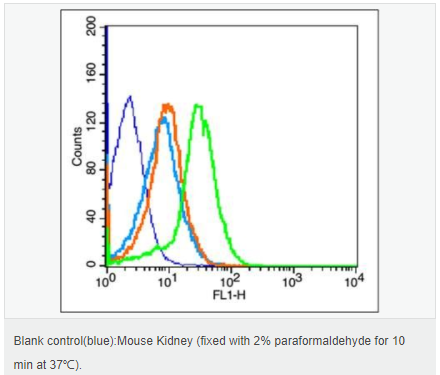

貨號
產(chǎn)品規(guī)格
售價(jià)
備注
BN41944R-50ul
50ul
¥1486.00
交叉反應(yīng):Human,Mouse,Rat(predicted:Pig) 推薦應(yīng)用:WB,Flow-Cyt,ELISA
BN41944R-100ul
100ul
¥2360.00
交叉反應(yīng):Human,Mouse,Rat(predicted:Pig) 推薦應(yīng)用:WB,Flow-Cyt,ELISA
BN41944R-200ul
200ul
¥3490.00
交叉反應(yīng):Human,Mouse,Rat(predicted:Pig) 推薦應(yīng)用:WB,Flow-Cyt,ELISA
產(chǎn)品描述
| 英文名稱 | CD95/FAS |
| 中文名稱 | 載脂蛋白1抗體 |
| 別 名 | Apo-1; ALPS 1A; ALPS1A; APO 1; Apo 1 antigen; APO 1 cell surface antigen; Apo-1 antigen; APO1; Apo1 antigen; APO1 cell surface antigen; Apoptosis antigen 1; Apoptosis mediating surface antigen FAS; Apoptosis-mediating surface antigen FAS; APT 1; APT1; CD 95; CD 95 antigen; CD95; CD95 antigen; Delta Fas; Delta Fas/APO 1/CD95; Delta Fas/APO1/CD95; FAS 1; FAS 827dupA; Fas AMA; FAS; FAS Antigen; FAS1; FASLG receptor; FASTM; TNF receptor superfamily, member 6; TNFRSF 6; TNFRSF6; TNR6_HUMAN; Tumor necrosis factor receptor superfamily member 6. |
| 研究領(lǐng)域 | 細(xì)胞生物 免疫學(xué) 細(xì)胞凋亡 |
| 抗體來源 | Rabbit |
| 克隆類型 | Polyclonal |
| 交叉反應(yīng) | Human, Mouse, Rat, (predicted: Pig, ) |
| 產(chǎn)品應(yīng)用 | WB=1:500-2000 ELISA=1:5000-10000 Flow-Cyt=1μg/Test not yet tested in other applications. optimal dilutions/concentrations should be determined by the end user. |
| 分 子 量 | 34kDa |
| 細(xì)胞定位 | 細(xì)胞膜 分泌型蛋白 |
| 性 狀 | Liquid |
| 濃 度 | 1mg/ml |
| 免 疫 原 | KLH conjugated synthetic peptide derived from human FAS/Apo-1/CD95:81-170/335 <Extracellular> |
| 亞 型 | IgG |
| 純化方法 | affinity purified by Protein A |
| 儲 存 液 | 0.01M TBS(pH7.4) with 1% BSA, 0.03% Proclin300 and 50% Glycerol. |
| 保存條件 | Shipped at 4℃. Store at -20 °C for one year. Avoid repeated freeze/thaw cycles. |
| PubMed | PubMed |
| 產(chǎn)品介紹 | Receptor for TNFSF6/FASLG. The adapter molecule FADD recruits caspase-8 to the activated receptor. The resulting death-inducing signaling complex (DISC) performs caspase-8 proteolytic activation which initiates the subsequent cascade of caspases (aspartate-specific cysteine proteases) mediating apoptosis. FAS-mediated apoptosis may have a role in the induction of peripheral tolerance, in the antigen-stimulated suicide of mature T-cells, or both. The secreted isoforms 2 to 6 block apoptosis (in vitro). Function: Receptor for TNFSF6/FASLG. The adapter molecule FADD recruits caspase-8 to the activated receptor. The resulting death-inducing signaling complex (DISC) performs caspase-8 proteolytic activation which initiates the subsequent cascade of caspases (aspartate-specific cysteine proteases) mediating apoptosis. FAS-mediated apoptosis may have a role in the induction of peripheral tolerance, in the antigen-stimulated suicide of mature T-cells, or both. The secreted isoforms 2 to 6 block apoptosis (in vitro). Subunit: Binds DAXX. Interacts with HIPK3. Part of a complex containing HIPK3 and FADD. Binds RIPK1 and FAIM2. Interacts with BRE and FEM1B. Interacts with FADD. Subcellular Location: Isoform 1: Cell membrane; Single-pass type I membrane protein. Isoform 2, 3, 4, 5, 6: Secreted. Tissue Specificity: Isoform 1 and isoform 6 are expressed at equal levels in resting peripheral blood mononuclear cells. After activation there is an increase in isoform 1 and decrease in the levels of isoform 6. Post-translational modifications: N- and O-glycosylated. O-glycosylated with core 1 or possibly core 8 glycans. DISEASE: Defects in FAS are the cause of autoimmune lymphoproliferative syndrome type 1A (ALPS1A) [MIM:601859]; also known as Canale-Smith syndrome (CSS). ALPS is a childhood syndrome involving hemolytic anemia and thrombocytopenia with massive lymphadenopathy and splenomegaly. Similarity: Contains 1 death domain. Contains 3 TNFR-Cys repeats. SWISS: P25445 Gene ID: 355 Database links: Entrez Gene: 355 Human Entrez Gene: 14102 Mouse Omim: 134637 Human SwissProt: P25445 Human SwissProt: P25446 Mouse Unigene: 244139 Human Unigene: 1626 Mouse Unigene: 162521 Rat Important Note: This product as supplied is intended for research use only, not for use in human, therapeutic or diagnostic applications |


